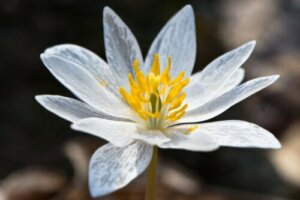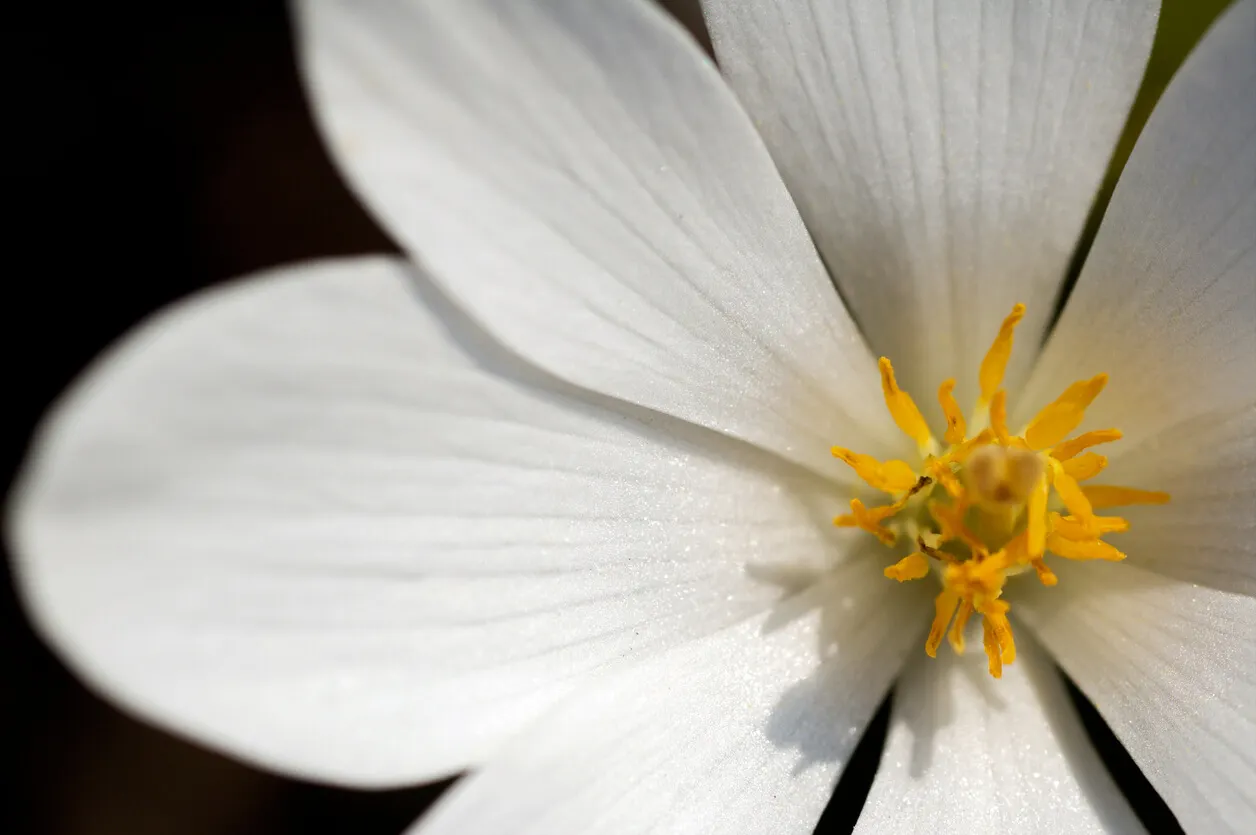Bloodroot Plant: Uses, Benefits and Contraindications


Reviewed and approved by the pharmacist Franciele Rohor de Souza
The bloodroot plant (scientific name Sanguinaria canadensis) is a flower native to the eastern United States and Canada. It belongs to the Papaveraceae (poppy) family and is also known by other names, such as bloodwart, Canada puccoon, and redroot. In particular, it’s noted for its applications in traditional medicine.
According to a review reported in the International Journal of Molecular Sciences, Native Americans have used the rhizomes of this plant to treat a wide variety of diseases. However, evidence of its properties is limited and, in fact, possible clinical toxicities have been observed. Do you want to know more about it? Here we’ll tell you more about its properties.
Uses and benefits of the bloodroot plant
Both the rhizome and roots of the bloodroot plant contain a red liquid that concentrates alkaloid compounds and antioxidants. Of these, sanguinarine has become the most researched alkaloid. In fact, much of the plant’s pharmacological effects are attributed to it. What is it used for?
Dental health
In the 1980s, bloodroot was used as an antimicrobial, antioxidant, and anti-inflammatory agent in dental health products. In particular, it’s said to decrease the presence of dental plaque and the risk of gingivitis.
Related to this, a study reported in Phytotherapy Research found that toothpaste and mouthwashes infused with Sanguinaria canadensis have antibacterial qualities that help protect oral health when used simultaneously. However, results regarding these effects are conflicting.
In fact, bloodroot mouth products have been discontinued in North America since 2001 after studies associated their use with an increased risk of precancerous lesions (oral leukoplakia).

Read more: Dental Hygiene for People with Celiac Disease
Skin health
In traditional medicine, bloodroot is used as an ally to combat skin problems such as acne, psoriasis, warts and blemishes. Nowadays, there are even products derived from the plant that claim to provide these and other skin benefits. But, is it effective for these purposes?
The truth is that there are no clinical studies that support its effectiveness against these conditions. On the contrary, as detailed in a publication in Dermatitis, excessive or improper application can lead to tissue destruction, contact dermatitis, and keloid formation.
Heart health
Sanguinarine, the main active compound in bloodroot, appears to have antianginal effects that decrease the buildup of plaque in the arteries and the risk of cardiac events. In addition, it’s thought to exert a positive inotropic effect, which helps the heart pump enough blood with fewer heartbeats.
Despite this, studies are insufficient to consider bloodroot as a therapeutic agent for heart health. On the contrary, experts warn that its use in high doses can cause a serious hypotension situation.
Respiratory health
Many of the applications of bloodroot have to do with respiratory health. In ancient times, it was a folk remedy for flu, colds, sinus infections, and lung infections. Despite this, there’s no solid evidence to show that it’s effective for these conditions.
Bloodroot plant risks and side effects
Bloodroot is considered safe for most healthy adults, as long as it’s consumed as a short-term, properly processed dietary supplement. Still, some people experience digestive discomfort after taking the plant in these forms.
Topical application is associated with side effects such as skin irritation, redness, and swelling. In addition, excessive or prolonged use may result in the following reactions:
- Dizziness and fainting
- Blurred vision or glaucoma
- Nausea and vomiting
- Low blood pressure
- Dilated pupils
- Diarrhea
Warning
Given the lack of evidence for its safety, the bloodroot plant shouldn’t be used in conditions such as pregnancy or lactation. Nor should it be used in children or patients with diagnosed chronic conditions.
On the other hand, we should also note that it may have interactions with drugs to lower blood pressure, anticoagulants and antiarrhythmics.

Read more: The 6 Best Medicinal Plants with Scientific Proof
Dosage and presentations
Right now, bloodroot plant is available in herbalist shops and online pharmacies as a supplement in capsules, powder and extracts. It’s also possible to find its dried roots for making teas or decoctions.
However, there’s no specific rule for safe intake. In general, experts suggest that we shouldn’t exceed doses of more than 5 micrograms of sanguinarine.
What to remember about bloodroot?
Bloodroot dietary supplements are distributed as allies to improve our health. Although their medicinal applications are quite old, clinical studies haven’t been able to prove their effectiveness. On the contrary, it has been determined that its improper or excessive use can cause serious consequences.
For this reason, it’s essential to use this plant in moderation, according to the manufacturer’s instructions. In addition, if you have a diagnosed condition or disease, it’s best to consult a doctor before using any derivative of this plant.
All cited sources were thoroughly reviewed by our team to ensure their quality, reliability, currency, and validity. The bibliography of this article was considered reliable and of academic or scientific accuracy.
- Croaker A, King GJ, Pyne JH, Anoopkumar-Dukie S, Liu L. Sanguinaria canadensis: Traditional Medicine, Phytochemical Composition, Biological Activities and Current Uses. Int J Mol Sci. 2016 Aug 27;17(9):1414. doi: 10.3390/ijms17091414. PMID: 27618894; PMCID: PMC5037693.
- Basu P, Kumar GS. Sanguinarine and Its Role in Chronic Diseases. Adv Exp Med Biol. 2016;928:155-172. doi: 10.1007/978-3-319-41334-1_7. PMID: 27671816.
-
Wang MZ, Warshaw EM. Bloodroot. Dermatitis. 2012 Nov-Dec;23(6):281-3. doi: 10.1097/DER.0b013e318273a4dd. PMID: 23169210.
-
Mackraj I, Govender T, Gathiram P. Sanguinarine. Cardiovasc Ther. 2008 Spring;26(1):75-83. doi: 10.1111/j.1527-3466.2007.00037.x. PMID: 18466423.
-
Mazzio EA, Soliman KF. In vitro screening for the tumoricidal properties of international medicinal herbs. Phytother Res. 2009;23(3):385-398. doi:10.1002/ptr.2636
- Gibb GD. The Sanguinaria Canadensis: Its Natural History, Properties, and Medical Uses. Br Med J. 1860;1(162):89-90.
This text is provided for informational purposes only and does not replace consultation with a professional. If in doubt, consult your specialist.








